Early Mississippian Culture on:
[Wikipedia]
[Google]
[Amazon]
 The Mississippian culture was a Native American civilization that flourished in what is now the Midwestern, Eastern, and Southeastern United States from approximately 800 CE to 1600 CE, varying regionally. It was known for building large, earthen platform mounds, and often other shaped mounds as well. It was composed of a series of urban settlements and satellite villages linked together by loose trading networks. The largest city was Cahokia, believed to be a major religious center located in what is present-day southern Illinois.
The Mississippian way of life began to develop in the Mississippi River Valley (for which it is named). Cultures in the tributary Tennessee River Valley may have also begun to develop Mississippian characteristics at this point. Almost all dated Mississippian sites predate 1539–1540 (when
The Mississippian culture was a Native American civilization that flourished in what is now the Midwestern, Eastern, and Southeastern United States from approximately 800 CE to 1600 CE, varying regionally. It was known for building large, earthen platform mounds, and often other shaped mounds as well. It was composed of a series of urban settlements and satellite villages linked together by loose trading networks. The largest city was Cahokia, believed to be a major religious center located in what is present-day southern Illinois.
The Mississippian way of life began to develop in the Mississippi River Valley (for which it is named). Cultures in the tributary Tennessee River Valley may have also begun to develop Mississippian characteristics at this point. Almost all dated Mississippian sites predate 1539–1540 (when




 A number of cultural traits are recognized as being characteristic of the Mississippians. Although not all Mississippian peoples practiced all of the following activities, they were distinct from their ancestors in the adoption of some or all of these traits.
#The construction of large, truncated earthwork pyramid mounds, or platform mounds. Such mounds were usually square, rectangular, or occasionally circular. Structures (domestic houses, temples, burial buildings, or other) were usually constructed atop such mounds.
# Maize-based agriculture. In most places, the development of Mississippian culture coincided with the adoption of comparatively large-scale, intensive maize agriculture, which supported larger populations and craft specialization.
# Shell-tempered pottery. The adoption and use of riverine (or more rarely marine) shells as tempering agents in ceramics.
#Widespread trade networks extending as far west as the Rocky Mountains, north to the Great Lakes, south to the Gulf of Mexico, and east to the Atlantic Ocean.
#The development of the chiefdom or complex chiefdom level of social complexity.
#The development of institutionalized social inequality.
#A centralization of control of combined political and religious power in the hands of few or one.
#The beginnings of a settlement hierarchy, in which one major center (with mounds) has clear influence or control over a number of lesser communities, which may or may not possess a smaller number of mounds.
#The adoption of the paraphernalia of the Southeastern Ceremonial Complex (SECC), also called the Southern Cult. This is the belief system of the Mississippians as we know it. SECC items are found in Mississippian-culture sites from Wisconsin (see Aztalan State Park) to the Gulf Coast, and from Florida to Arkansas and
A number of cultural traits are recognized as being characteristic of the Mississippians. Although not all Mississippian peoples practiced all of the following activities, they were distinct from their ancestors in the adoption of some or all of these traits.
#The construction of large, truncated earthwork pyramid mounds, or platform mounds. Such mounds were usually square, rectangular, or occasionally circular. Structures (domestic houses, temples, burial buildings, or other) were usually constructed atop such mounds.
# Maize-based agriculture. In most places, the development of Mississippian culture coincided with the adoption of comparatively large-scale, intensive maize agriculture, which supported larger populations and craft specialization.
# Shell-tempered pottery. The adoption and use of riverine (or more rarely marine) shells as tempering agents in ceramics.
#Widespread trade networks extending as far west as the Rocky Mountains, north to the Great Lakes, south to the Gulf of Mexico, and east to the Atlantic Ocean.
#The development of the chiefdom or complex chiefdom level of social complexity.
#The development of institutionalized social inequality.
#A centralization of control of combined political and religious power in the hands of few or one.
#The beginnings of a settlement hierarchy, in which one major center (with mounds) has clear influence or control over a number of lesser communities, which may or may not possess a smaller number of mounds.
#The adoption of the paraphernalia of the Southeastern Ceremonial Complex (SECC), also called the Southern Cult. This is the belief system of the Mississippians as we know it. SECC items are found in Mississippian-culture sites from Wisconsin (see Aztalan State Park) to the Gulf Coast, and from Florida to Arkansas and

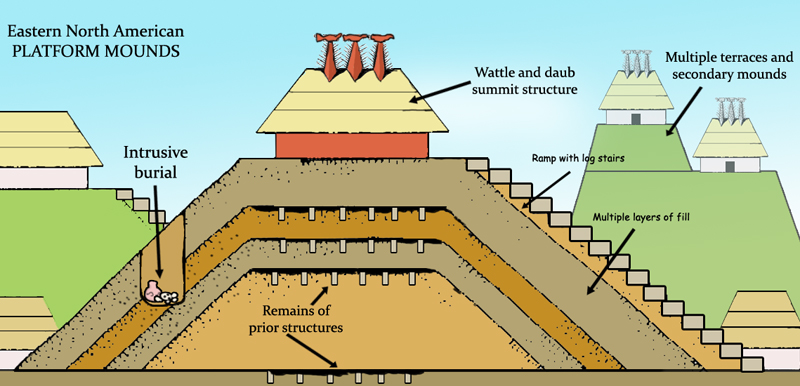
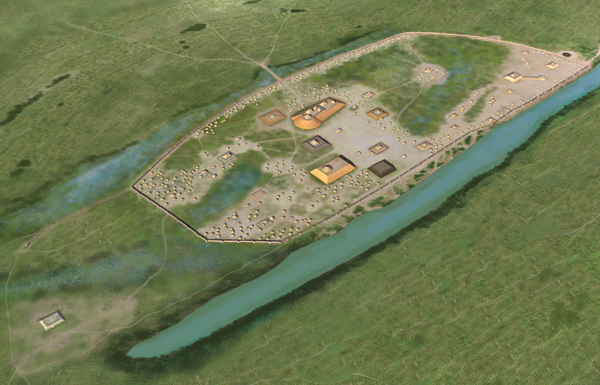 The term ''Middle Mississippian'' is also used to describe the core of the classic Mississippian culture area. This area covers the central Mississippi River Valley, the lower Ohio River Valley, and most of the Mid-South area, including western and central Kentucky, western Tennessee, and northern Alabama and Mississippi. Sites in this area often contain large ceremonial platform mounds, residential complexes and are often encircled by earthen ditches and ramparts or
The term ''Middle Mississippian'' is also used to describe the core of the classic Mississippian culture area. This area covers the central Mississippi River Valley, the lower Ohio River Valley, and most of the Mid-South area, including western and central Kentucky, western Tennessee, and northern Alabama and Mississippi. Sites in this area often contain large ceremonial platform mounds, residential complexes and are often encircled by earthen ditches and ramparts or
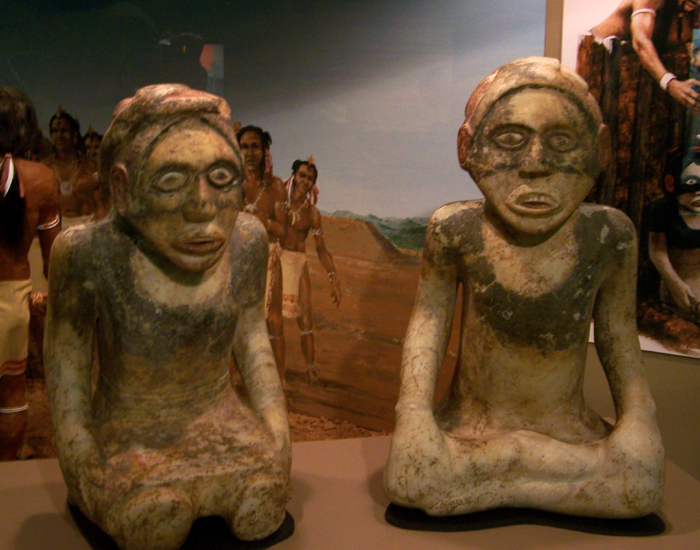 The term ''South Appalachian Province'' was originally used by
The term ''South Appalachian Province'' was originally used by

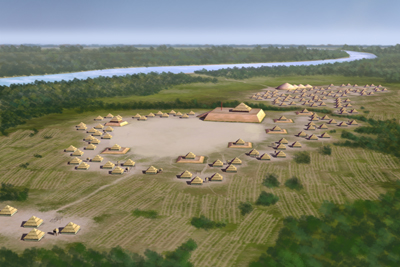 The Caddoan Mississippian area, a regional variant of the Mississippian culture, covered a large territory, including what is now eastern
The Caddoan Mississippian area, a regional variant of the Mississippian culture, covered a large territory, including what is now eastern
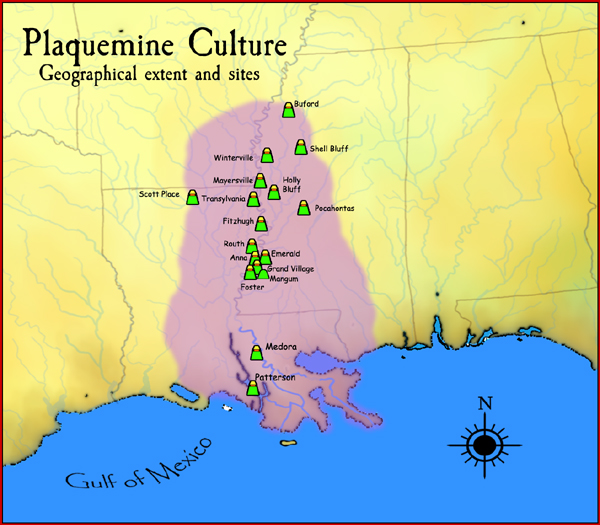 The Plaquemine culture was an
The Plaquemine culture was an
 Scholars have studied the records of
Scholars have studied the records of
The Mississippian and Late Prehistoric Period
National Park Service Southeastern Archaeology Center, archived at Internet Archive
Mississippian World
Texas Beyond History
Indian Mounds of Mississippi, a National Park Service ''Discover Our Shared Heritage'' Travel Itinerary
* Moundville Archaeological Parkbr>
*
Archaeological siteMississippian Period
in '' Encyclopedia of Alabama''
Animation: Towns and Temples of the Mississippian Culture-5 Sites
{{DEFAULTSORT:Mississippian culture Mound builders (people) Archaeological cultures of North America History of indigenous peoples of North America Native American history Formative period in the Americas Indigenous peoples of the Southeastern Woodlands Great Lakes tribes Mississippi River Pre-Columbian civilizations Post-Archaic period in North America 8th-century establishments in North America 16th-century disestablishments in North America Pyramids in the United States
 The Mississippian culture was a Native American civilization that flourished in what is now the Midwestern, Eastern, and Southeastern United States from approximately 800 CE to 1600 CE, varying regionally. It was known for building large, earthen platform mounds, and often other shaped mounds as well. It was composed of a series of urban settlements and satellite villages linked together by loose trading networks. The largest city was Cahokia, believed to be a major religious center located in what is present-day southern Illinois.
The Mississippian way of life began to develop in the Mississippi River Valley (for which it is named). Cultures in the tributary Tennessee River Valley may have also begun to develop Mississippian characteristics at this point. Almost all dated Mississippian sites predate 1539–1540 (when
The Mississippian culture was a Native American civilization that flourished in what is now the Midwestern, Eastern, and Southeastern United States from approximately 800 CE to 1600 CE, varying regionally. It was known for building large, earthen platform mounds, and often other shaped mounds as well. It was composed of a series of urban settlements and satellite villages linked together by loose trading networks. The largest city was Cahokia, believed to be a major religious center located in what is present-day southern Illinois.
The Mississippian way of life began to develop in the Mississippi River Valley (for which it is named). Cultures in the tributary Tennessee River Valley may have also begun to develop Mississippian characteristics at this point. Almost all dated Mississippian sites predate 1539–1540 (when Hernando de Soto
Hernando de Soto (; ; 1500 – 21 May, 1542) was a Spanish explorer and '' conquistador'' who was involved in expeditions in Nicaragua and the Yucatan Peninsula. He played an important role in Francisco Pizarro's conquest of the Inca Empire ...
explored the area), with notable exceptions being Natchez communities. These maintained Mississippian cultural practices into the 18th century.
Cultural traits




Oklahoma
Oklahoma (; Choctaw language, Choctaw: ; chr, ᎣᎧᎳᎰᎹ, ''Okalahoma'' ) is a U.S. state, state in the South Central United States, South Central region of the United States, bordered by Texas on the south and west, Kansas on the nor ...
. The SECC was frequently tied into ritual game-playing, as with chunkey.
The Mississippians had no writing system or stone architecture. They worked naturally occurring metal deposits, such as hammering and annealing copper for ritual objects such as Mississippian copper plates and other decorations, but did not smelt iron or practice bronze metallurgy
Metallurgy is a domain of materials science and engineering that studies the physical and chemical behavior of metallic elements, their inter-metallic compounds, and their mixtures, which are known as alloys.
Metallurgy encompasses both the sc ...
.
Chronology
The Mississippi stage is usually divided into three or more chronological periods. Each period is an arbitrary historical distinction varying regionally. At a particular site, each period may be considered to begin earlier or later, depending on the speed of adoption or development of given Mississippian traits. The "Mississippi period" should not be confused with the "Mississippian culture". The Mississippi period is the chronological stage, while Mississippian culture refers to the cultural similarities that characterize this society. *The Early Mississippi period (c. 1000–1200 CE) had just transitioned from the Late Woodland period way of life (500–1000). Different groups abandoned tribal lifeways for increasing complexity, sedentism, centralization, and agriculture. Production of surplus corn and attractions of the regional chiefdoms led to rapid population concentrations in major centers. *The Middle Mississippi period (c. 1200–1400) is the apex of the Mississippi era. The expansion of the great metropolis and ceremonial complex at Cahokia (in present-day Illinois), the formation of other complex chiefdoms, and the spread and development of SECC art and symbolism are characteristic changes of this period. The Mississippian traits listed above came to be widespread throughout the region. *The Late Mississippi period (c. 1400–1540) is characterized by increasing warfare, political turmoil, and population movement. The population of Cahokia dispersed early in this period (1350–1400), perhaps migrating to other rising political centers. More defensive structures are often seen at sites, and sometimes a decline in mound-building and large-scale, public ceremonialism. Although some areas continued an essentially Middle Mississippian culture until the first significant contact with Europeans, the population of most areas had dispersed or were experiencing severe social stress by 1500. Along with the contemporaneous Ancestral Pueblo peoples, these cultural collapses coincide with the global climate change of theLittle Ice Age
The Little Ice Age (LIA) was a period of regional cooling, particularly pronounced in the North Atlantic region. It was not a true ice age of global extent. The term was introduced into scientific literature by François E. Matthes in 1939. Ma ...
. Scholars theorize drought and the reduction of maize agriculture, together with possible deforestation and overhunting by the concentrated populations, forced them to move away from major sites. This period ended with European contact in the 16th century.
Regional variations
Middle Mississippian

 The term ''Middle Mississippian'' is also used to describe the core of the classic Mississippian culture area. This area covers the central Mississippi River Valley, the lower Ohio River Valley, and most of the Mid-South area, including western and central Kentucky, western Tennessee, and northern Alabama and Mississippi. Sites in this area often contain large ceremonial platform mounds, residential complexes and are often encircled by earthen ditches and ramparts or
The term ''Middle Mississippian'' is also used to describe the core of the classic Mississippian culture area. This area covers the central Mississippi River Valley, the lower Ohio River Valley, and most of the Mid-South area, including western and central Kentucky, western Tennessee, and northern Alabama and Mississippi. Sites in this area often contain large ceremonial platform mounds, residential complexes and are often encircled by earthen ditches and ramparts or palisade
A palisade, sometimes called a stakewall or a paling, is typically a fence or defensive wall made from iron or wooden stakes, or tree trunks, and used as a defensive structure or enclosure. Palisades can form a stockade.
Etymology
''Palisade' ...
s.
Middle Mississippian cultures, especially the Cahokia polity located near East St. Louis, Illinois, were very influential on neighboring societies. High-status artifacts, including stone statuary and elite pottery associated with Cahokia, have been found far outside of the Middle Mississippian area. These items, especially the pottery, were also copied by local artists.
* Cahokia: The largest and most complex Mississippian site and the largest Pre-Columbian settlement north of Mexico, Cahokia is considered to have been the most influential of the Mississippian culture centers. Discoveries found at the massive site include evidence of copper working (Mound 34
Mound 34 is a small platform mound located roughly to the east of Monks Mound at Cahokia Mounds near Collinsville, Illinois. Excavations near Mound 34 from 2002 to 2010 revealed the remains of a copper workshop, although the one of a kind discove ...
), astronomy ( Cahokia Woodhenge and the symbolic maximum southern moon rise aligned Rattlesnake Causeway
The Cahokia Mounds State Historic Site ( 11 MS 2) is the site of a pre-Columbian Native American city (which existed 1050–1350 CE) directly across the Mississippi River from modern St. Louis, Missouri. This historic park lies in south-w ...
), and ritual retainer burials ( Mound 72).
* Angel Mounds: A chiefdom in southern Indiana near Evansville. It is thought by some archaeologists that the Late Mississippian Caborn-Welborn culture
Caborn-Welborn was a precontact and proto-historic North American culture defined by archaeologists as a Late Mississippian cultural manifestation that grew out of – or built upon the demise of – the Angel chiefdom located in present-day sout ...
developed from the Angel phase people around 1400 CE and lasted to around 1700 CE.
*Kincaid site
The Kincaid Mounds Historic Site ( 11MX2-11; 11PO2-10) , is a Mississippian culture archaeological site located at the southern tip of present-day U.S. state of Illinois, along the Ohio River. Kincaid Mounds has been notable for both its sig ...
: A major Mississippian mound center in southern Illinois across the Ohio River
The Ohio River is a long river in the United States. It is located at the boundary of the Midwestern and Southern United States, flowing southwesterly from western Pennsylvania to its mouth on the Mississippi River at the southern tip of Illino ...
from Paducah, Kentucky.
* Moundville: Ranked with Cahokia as one of the two most important sites at the core of the Mississippian culture, located near Tuscaloosa, Alabama.
* The Parkin site: The type site for the "Parkin phase", an expression of Late Mississippian culture, believed by many archaeologists to be the province of Casqui visited by Hernando de Soto in 1542.
South Appalachian Mississippian
 The term ''South Appalachian Province'' was originally used by
The term ''South Appalachian Province'' was originally used by W. H. Holmes
William Henry Holmes (December 1, 1846 – April 20, 1933), known as W. H. Holmes, was an American explorer, anthropologist, archaeologist, artist, scientific illustrator, cartographer, mountain climber, geologist and museum curator and direc ...
in 1903 to describe a regional ceramic style in the southeast involving surface decorations applied with a carved wooden paddle. By the late 1960s, archaeological investigations had shown the similarity of the culture that produced the pottery and the midwestern ''Mississippian pattern'' defined in 1937 by the Midwestern Taxonomic System.
In 1967 James B. Griffin
James Bennett Griffin or Jimmy Griffin (January 12, 1905 – May 31, 1997) was an American archaeologist. He is regarded as one of the most influential archaeologists in North America in the 20th century.
Personal life
Born in Atchison, Kans ...
coined ''South Appalachian Mississippian'' to describe the evolving understanding of the peoples of the Southeast. South Appalachian Mississippian area sites are distributed across a contiguous area including Alabama, Georgia, northern Florida, South Carolina, central and western North Carolina, and Tennessee. Chronologically this area became influenced by Mississippian culture later than the Middle Mississippian area (about 1000 CE as compared to 800 CE) to its northwest. It is believed that the peoples of this area adopted Mississippian traits from their northwestern neighbors.
Typical settlements were located on riverine floodplains and included villages with defensive palisades enclosing platform mounds and residential areas. Etowah and Ocmulgee
The Ocmulgee River () is a western tributary of the Altamaha River, approximately 255 mi (410 km) long, in the U.S. state of Georgia. It is the westernmost major tributary of the Altamaha.
in Georgia are both prominent examples of major South Appalachian Mississippian settlements. Both include multiple large earthwork mounds serving a variety of functions.
Villages with single platform mounds were more typical of the river valley settlements throughout the mountainous area of southwest North and South Carolina, and southeastern Tennessee that were known as the historic Cherokee homelands. In Western North Carolina for example; some 50 such mound sites in the eleven westernmost counties have been identified since the late 20th century, following increased research in this area of the Cherokee homeland.
Caddoan Mississippian

 The Caddoan Mississippian area, a regional variant of the Mississippian culture, covered a large territory, including what is now eastern
The Caddoan Mississippian area, a regional variant of the Mississippian culture, covered a large territory, including what is now eastern Oklahoma
Oklahoma (; Choctaw language, Choctaw: ; chr, ᎣᎧᎳᎰᎹ, ''Okalahoma'' ) is a U.S. state, state in the South Central United States, South Central region of the United States, bordered by Texas on the south and west, Kansas on the nor ...
, western Arkansas, northeastern Texas, and northwestern Louisiana. Archaeological evidence has led to a scholarly consensus that the cultural continuity is unbroken from prehistory to the present, and that the Caddo
The Caddo people comprise the Caddo Nation of Oklahoma, a federally recognized tribe headquartered in Binger, Oklahoma. They speak the Caddo language.
The Caddo Confederacy was a network of Indigenous peoples of the Southeastern Woodlands, wh ...
and related Caddo language speakers in prehistoric times and at first European contact are the direct ancestors of the modern Caddo Nation of Oklahoma.
The climate in this area was drier than areas in the eastern woodlands, hindering maize production, and the lower population on the plains to the west may have meant fewer neighboring competing chiefdoms to contend with. Major sites such as Spiro and the Battle Mound Site are in the Arkansas River and Red River Valleys, the largest and most fertile of the waterways in the Caddoan region, where maize agriculture would have been the most productive. The sites generally lacked wooden palisade
A palisade, sometimes called a stakewall or a paling, is typically a fence or defensive wall made from iron or wooden stakes, or tree trunks, and used as a defensive structure or enclosure. Palisades can form a stockade.
Etymology
''Palisade' ...
fortifications often found in the major Middle Mississippian towns. Living on the western edge of the Mississippian world, the Caddoans may have faced fewer military threats from their neighbors. Their societies may also have had a somewhat lower level of social stratification
Social stratification refers to a society's categorization of its people into groups based on socioeconomic factors like wealth, income, race, education, ethnicity, gender, occupation, social status, or derived power (social and political). As ...
.
The Caddoan people were speakers of one of the many Caddoan languages
The Caddoan languages are a family of languages native to the Great Plains spoken by tribal groups of the central United States, from present-day North Dakota south to Oklahoma. All Caddoan languages are critically endangered, as the number of sp ...
. These languages once had a broad geographic distribution, but many are now extinct. The modern languages in the Caddoan family include Caddo and Pawnee.
Hernando de Soto led an expedition into the area in the early 1540s, he encountered several native groups now thought to have been Caddoan. Composed of many tribes, the Caddo were organized into three confederacies, the Hasinai, Kadohadacho, and Natchitoches, which were all linked by their similar languages.
Plaquemine Mississippian
 The Plaquemine culture was an
The Plaquemine culture was an archaeological culture
An archaeological culture is a recurring assemblage of types of artifacts, buildings and monuments from a specific period and region that may constitute the material culture remains of a particular past human society. The connection between thes ...
in the lower Mississippi River Valley in western Mississippi and eastern Louisiana. Good examples of this culture are the Medora site (the type site for the culture and period) in West Baton Rouge Parish, Louisiana, and the Anna, Emerald Mound, Winterville and Holly Bluff sites located in Mississippi. Plaquemine culture was contemporaneous with the Middle Mississippian culture at the Cahokia site near St. Louis, Missouri. It is considered ancestral to the Natchez and Taensa Peoples.
* Emerald Mound: A Plaquemine Mississippian
The Plaquemine culture was an archaeological culture (circa 1200 to 1700 CE) centered on the Lower Mississippi River valley. It had a deep history in the area stretching back through the earlier Coles Creek (700-1200 CE) and Troyville cultures ( ...
period archaeological site located on the Natchez Trace Parkway
The Natchez Trace Parkway is a national parkway in the southeastern United States that commemorates the historic Natchez Trace and preserves sections of that original trail. Its central feature is a two-lane road that extends 444 miles (715 ...
near Stanton, Mississippi
Stanton is an unincorporated community in Adams County, Mississippi. It is the nearest community to Emerald Mound site, a National Historic Landmark.
History
Stanton is located on a branch of the former Yazoo and Mississippi Valley Railroad
The ...
. The site dates from the period between 1200 and 1730. The platform mound is the second-largest Pre-Columbian earthwork in the country, after Monks Mound at Cahokia.
* Grand Village of the Natchez: The main village of the Natchez people, with three mounds. The only mound site to be used and maintained into historic times.
Known Mississippian settlements
Although the Mississippian culture was heavily disrupted before a complete understanding of the political landscape was written down, many Mississippian political bodies were documented and others have been discovered by research.Related modern nations
Mississippian peoples were almost certainly ancestral to the majority of the American Indian nations living in this region in the historic era. The historic and modern day American Indian nations believed to have descended from the overarching Mississippian culture include: the Alabama, Apalachee,Caddo
The Caddo people comprise the Caddo Nation of Oklahoma, a federally recognized tribe headquartered in Binger, Oklahoma. They speak the Caddo language.
The Caddo Confederacy was a network of Indigenous peoples of the Southeastern Woodlands, wh ...
, Chickasaw, Catawba, Choctaw
The Choctaw (in the Choctaw language, Chahta) are a Native American people originally based in the Southeastern Woodlands, in what is now Alabama and Mississippi. Their Choctaw language is a Western Muskogean language. Today, Choctaw people are ...
, Muscogee Creek, Guale, Hitchiti, Ho-Chunk
The Ho-Chunk, also known as Hoocągra or Winnebago (referred to as ''Hotúŋe'' in the neighboring indigenous Iowa-Otoe language), are a Siouan-speaking Native American people whose historic territory includes parts of Wisconsin, Minnesota, Iow ...
, Houma, Kansa, Missouria, Mobilian, Natchez, Osage The Osage Nation, a Native American tribe in the United States, is the source of most other terms containing the word "osage".
Osage can also refer to:
* Osage language, a Dhaegin language traditionally spoken by the Osage Nation
* Osage (Unicode b ...
, Quapaw, Seminole, Tunica-Biloxi, Yamasee, and Yuchi.
Contact with Europeans
 Scholars have studied the records of
Scholars have studied the records of Hernando de Soto
Hernando de Soto (; ; 1500 – 21 May, 1542) was a Spanish explorer and '' conquistador'' who was involved in expeditions in Nicaragua and the Yucatan Peninsula. He played an important role in Francisco Pizarro's conquest of the Inca Empire ...
's expedition of 1539–1543 to learn of his contacts with Mississippians, as he traveled through their villages of the Southeast. He visited many villages, in some cases staying for a month or longer. The list of sites and peoples visited by the Hernando de Soto Expedition chronicles those villages. Some encounters were violent, while others were relatively peaceful. In some cases, de Soto seems to have been used as a tool or ally in long-standing native feuds. In one example, de Soto negotiated a truce between the Pacaha and the Casqui.
De Soto's later encounters left about half of the Spaniards and perhaps many hundreds of Native Americans dead. The chronicles of de Soto are among the first documents written about Mississippian peoples and are an invaluable source of information on their cultural practices. The chronicles of the Narváez expedition were written before the de Soto expedition; the Narváez expedition informed the Court of de Soto about the New World.
After the destruction and flight of the de Soto expedition, the Mississippian peoples continued their way of life with little direct European influence. Indirectly, however, European introductions dramatically changed these native societies. Because the natives lacked immunity to infectious diseases
An infection is the invasion of tissues by pathogens, their multiplication, and the reaction of host tissues to the infectious agent and the toxins they produce. An infectious disease, also known as a transmissible disease or communicable dise ...
unknowingly carried by the Europeans, such as measles
Measles is a highly contagious infectious disease caused by measles virus. Symptoms usually develop 10–12 days after exposure to an infected person and last 7–10 days. Initial symptoms typically include fever, often greater than , cough, ...
and smallpox, epidemics caused so many fatalities that they undermined the social order of many chiefdoms. Some groups adopted European horses and changed to nomadism. Political structures collapsed in many places.
At Joara, near Morganton, North Carolina
Morganton is a city in and the county seat of Burke County, North Carolina, United States. The population was 16,918 at the 2010 census. Morganton is approximately northwest of Charlotte.
Morganton is one of the principal cities in the Hick ...
, Native Americans of the Mississippian culture interacted with Spanish colonizers of the Juan Pardo expedition, who built a base there in 1567 called Fort San Juan. Expedition documentation and archaeological evidence of the fort and Native American culture both exist. The soldiers were at the fort about 18 months (1567–1568) before the natives killed them and destroyed the fort. (They killed soldiers stationed at five other forts as well; only one man of 120 survived.) Sixteenth-century Spanish artifacts have been recovered from the site, marking the first European colonization in the interior of what became the United States.
By the time more documentary accounts were being written, the Mississippian way of life had changed irrevocably. Some groups maintained an oral tradition link to their mound-building past, such as the late 19th-century Cherokee.Hudson pp. 334 Other Native American groups, having migrated many hundreds of miles and lost their elders to diseases, did not know their ancestors had built the mounds dotting the landscape. This contributed to the myth of the Mound Builders as a people distinct from Native Americans, which was rigorously debunked by Cyrus Thomas in 1894.
See also
* List of Mississippian sites * List of burial mounds in the United States * Ocmulgee Mounds National Historical Park * Southeastern Ceremonial ComplexNotes
References
* Bense, Judith A. ''Archaeology of the Southeastern United States: Paleoindian to World War I''. Academic Press, New York, 1994. . * Cheryl Anne Cox; and David H. Dye, eds; ''Towns and Temples along the Mississippi.'' University of Alabama Press, 1990 * Hudson, Charles; ''The Southeastern Indians''. University of Tennessee Press, Knoxville, 1976. . * Keyes, Charles R. Prehistoric Man in Iowa. Palimpsest 8(6):185–229. (1927). * O'Connor, Mallory McCane. ''Lost Cities of the Ancient Southeast.'' University Press of Florida, Florida A & M University, Gainesville, Fla., 1995. . * Pauketat, Timothy R.; ''The Ascent of Chiefs: Cahokia and Mississippian Politics in Native North America''. University of Alabama Press, 1994, . * Pauketat, Timothy R.; "The Forgotten History of the Mississippians" in ''North American Archaeology.'' Blackwell Publishing Ltd., 2005.External links
The Mississippian and Late Prehistoric Period
National Park Service Southeastern Archaeology Center, archived at Internet Archive
Mississippian World
Texas Beyond History
* Moundville Archaeological Parkbr>
*
Chucalissa Museum
The C.H. Nash Museum at Chucalissa is located on and exhibits excavated materials of the Mississippian culture archaeological site known as Chucalissa ( 40 SY 1) which means "abandoned house" in Chickasaw. The site is located adjacent to the T. O ...
anArchaeological site
in '' Encyclopedia of Alabama''
Animation: Towns and Temples of the Mississippian Culture-5 Sites
{{DEFAULTSORT:Mississippian culture Mound builders (people) Archaeological cultures of North America History of indigenous peoples of North America Native American history Formative period in the Americas Indigenous peoples of the Southeastern Woodlands Great Lakes tribes Mississippi River Pre-Columbian civilizations Post-Archaic period in North America 8th-century establishments in North America 16th-century disestablishments in North America Pyramids in the United States